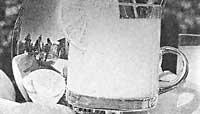After sweating, what?
1994/07/01 Agirre, Jabier - Medikua eta OEEko kidea Iturria: Elhuyar aldizkaria
If you ask anyone, the answers would be similar: with sweat the body expels dirt, waste, moods (good and bad) and other non-purities. With sweat we clean the body.
And following with that intention or conviction, it is there where we are all forcing health, covering well the body with many plastics and asking for efforts to the heart, or entering the sauna, spending nice coins on special products or artifacts that stimulate sweat.
The favors of the sauna are undeniable (although it is attributed some less favorable damages or effects, such as those cited below), but nevertheless, it has achieved more success in people because it thinks that in it it is weakened than by its real effects (relaxation, relief of joint pain and decrease of blood pressure are those that are accepted unanimously). And the idea is very widespread that with sweating, even with the expulsion of toxins, even if there is no scientific reason for this.

A study in the universities of Florida and Arizona has shown the need to distinguish two types of sweat glands: the apocrine glands on one side and the ecrines on the other.
The apocrine glands are located on the palms of the hands, feet, armpits and groins, and flow together with water lipid molecules that give off a quite amazing smell. The main function of these glands is the emission of a signal; sending to other beings of the same kind of information about risks, attacks, threats, reproaches, etc.
The ecrine glands are distributed homogenously throughout the entire body. When body temperature rises by normal level, these glands secrete ultrafiltrated water by blood plasma under the hypothalamus stimulus. The function of the ecrine glands is, therefore, a refreshing one, since by evaporating or evaporating water in the skin this effect is achieved. In sweat, in addition to water, other substances present in the composition of the blood are lost, such as sodium, potassium and chlorine, and in very small amounts can be found urea, lactic acid, magnesium, nitrogen, iron and zinc.
Although the loss of these substances in dissolution in sweat is a deficit of chemical elements, water is first, and, in addition to immediately, at its normal levels, to avoid the risk of dehydration. However, when much is sweated, other mechanisms are put in place for the conservation of water in the body: the pituitary gland secretes the antidiuretic hormone so that the kidneys recover water and resist sodium; but this mechanism is not enough for the loss of water to be high, and excessive viscosity of the blood, caused by the loss of water, can cause extra effort and effort in the heart (which is created).
Dehydration has other harmful effects on the tissues that constitute the “showcase” of our external appearance: the water that filters from the blood plasma will be replaced immediately at the expense of the intracellular water, but this can cause dehydration of the tissues more or less serious. It is true that, at first glance, the loss of intracellular water “gives” a few centimeters less, for example in the thigh, which will allow us to believe that we have flacado.
But the truth is that both blood plasma and tissues, including skin, lack an essential component, lack of water, and without it neither health, nor youth, nor freshness, nor the tenderness or softness of the skin, are impossible.
It is painful, therefore, that an erroneous concept of sweat has caused that in recent times several improper methods of flaking have multiplied, since the loss of centimeter behind the loss of water is false and some diuretic diuretic pastillas camouflaged or disguised that have appeared on foot around the sweating.
In short, and in the words of Dr. Marcos Becerro, head of the medical team of the Spanish Olympic Committee: “The accidents caused by bad information about sweat are attributed to physical activity, which has serious consequences for public health.”
Risks of the sauna
In its measure, without excesses, the sauna is very suitable for the treatment of rheumatic diseases, stimulation of sweating and elimination of toxins (this last affirmation is not accepted by all experts, since it is not scientifically demonstrated). However, not everything is good, since misuse can cause hormonal and circulatory disorders and in the worst case sterility (in men and women).
Although this type of systematic research is very rare, according to urologists and gynecologists, 2 out of 1,000 people can become sterile if they spend more than a “normal” time in the sauna. The medical advice is that in no case more than 15 minutes, 3 times per week.
In the words of gynecologist Alonso Vidal, from La Paz hospital in Madrid, the inadequate use of the sauna is more harmful to men. The testicles cannot be placed at high temperatures, as they can suffer long-term adverse effects above the 36ºC of normal body temperature. “The production and quality of the sperm are affected.”
It is also common for women to have discomfort when they “pass” during the time they have spent in the sauna: intense sleep and neck pain, for example. In addition, changes can occur in some women during the month. The longer you spend in the sauna, the more serious they are.
Fernando Cruz, doctor of the Ramón y Cajal Hospital of Madrid, says that women do not know the possible consequences of the abuse of the sauna, but according to his research 60% of the women who come to the sauna with some assiduity have some discomfort for the improper use of the sauna.
Tips for Sweating
- Wear cotton clothing. Never “cover” plastic.
- Do not run with naked chest.
- When you do sport keep the water next door and drink even if you don't have much thirst.
- After sweating, drink with desire, recovering lost electrolytes with special formulas or with broth or gazpacho.
- If you are a woman and have a tendency to have anemia, exercise without sweating much.
- If you're a woman and you're pregnant, be careful that your body temperature doesn't reach a high level, because the fetus you carry inside can't cool off with sweat, even if you do.

Gai honi buruzko eduki gehiago
Elhuyarrek garatutako teknologia





